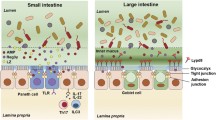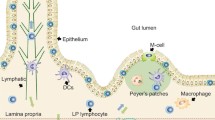Abstract.
There is an immense load of non-pathogenic commensal bacteria in the distal small intestine and the colon of mammals. The physical barrier that prevents penetration (translocation) of these organisms into the body is a simple epithelium comprised of the single enterocyte/colonocyte cell layer with its overlying mucus. In this review, we discuss the roles of intestinal T cells in initiating and regulating innate and adaptive mucosal immune responses of the mucosal immune system that avoid or limit penetration of the commensal intestinal bacteria.
Similar content being viewed by others
Author information
Authors and Affiliations
Additional information
Received 9 August 2002; accepted 9 September 2002
RID="*"
ID="*"Corresponding author.
Rights and permissions
About this article
Cite this article
Macpherson, A., Martinic, M. & Harris, N. The functions of mucosal T cells in containing the indigenous commensal flora of the intestine. CMLS, Cell. Mol. Life Sci. 59, 2088–2096 (2002). https://doi.org/10.1007/s000180200009
Issue Date:
DOI: https://doi.org/10.1007/s000180200009




